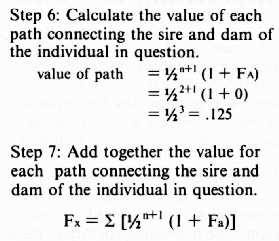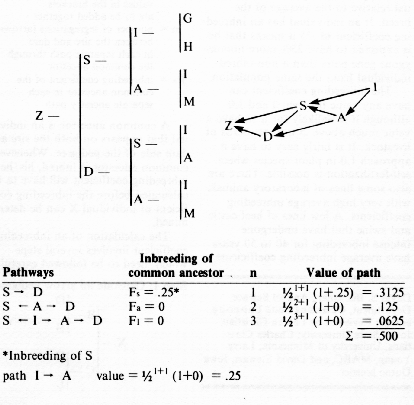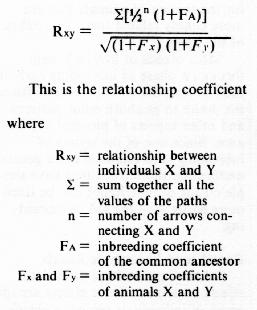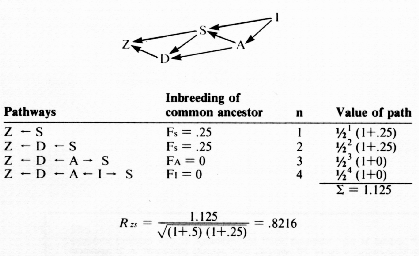
NSIF-FS4

Lauren Christian, Iowa State University
Charles Christians, University of Minnesota
Larry Young, MARC
David Stewart, Iowa Duroc breeder.
Inbreeding is the mating of related individuals. In the strict sense, all members of a breed are related. As a result, any seedstock producer is practicing some inbreeding. Therefore, we generally reserve the term inbreeding for the mating of animals that are more closely related than the average of the breed.
Most breeds of livestock went through a phase of inbreeding early in their development. This resulted from the desire to establish color patterns and other aspects of physical appearance. Since one of the results of inbreeding is to establish more genetic uniformity, those traits that have simple means of inheritance can be fixed more easily with the aid of inbreeding.
Inbreeding can have dramatic effects on a herd. These effects are the result of individuals receiving identical genes from each parent. If the parents are related it is more likely that they have identical genes. When an individual receives an identical gene from each parent it is said to be homozygous for that pair of genes. This would be desirable if the gene it received from each parent lead to superior performance. However, most animals carry undesirable genes that usually remain hidden unless that animal has a pair of them. An inbred individual is more likely to have gene pairs with identical members, so is more likely to express undesirable genes. This leads to a decline in performance called inbreeding depression. This phenomenon is well documented in all of the major livestock species. It is essentially the opposite of heterosis which is the advantage gained from crossing lines or breeds.
Inbreeding in an individual is measured with the inbreeding coefficient. The inbreeding coefficient measures the percentage increase in homozygous gene pairs in an individual relative to the average of the breed. If an individual has an inbreeding coefficient of .25 it means that he is expected to have 25% more homozygous gene pairs than a non-inbred individual from the same population.
The inbreeding coefficient can have any value between 0 and 1.0 although it is unlikely for it to have a value much above .5 in most herds of livestock. It is fairly easy to have it approach .0 in plant species where self-fertilization is possible. There are also some lines of laboratory animals with very high average inbreeding coefficients. A few lines of beef cattle and swine that have undergone intense inbreeding for 40 to 50 years have average inbreeding coefficients of .5 to .6. This takes many generations of full-sib or parent-offspring matings to accomplish. Therefore an inbreeding coefficient over .5 is unlikely in a purebred herd of pigs. The general formula for an inbreeding coefficient is as follows:

A common ancestor is an individual that appears on both the sire and dam side of the pedigree. Whenever a common ancestor is inbred, his/her inbreeding coefficient will have to be calculated before the inbreeding coefficient of individual X can be determined.
The calculation of an inbreeding coefficient involves several steps which need to be followed carefully.
Step 1: Generate an arrow pedigree


Step 2: List all paths that connect the sire and the dam.
Step 3: Locate the common ancestor in each path
The common ancestor is that individual that the arrows point away from. It is the ancestor that is in the pedigrees of both parents.
Step 4: Determine if the common ancestor in each path is inbred. If so, calculate the inbreeding coefficient of the common ancestors.
The rules for determining the inbreeding coefficient of the common ancestor are the same as for calculating the inbreeding coefficient of any other individual. If the common ancestor is inbred, simply construct its pedigree and go through each step of the process as if it were the individual of interest.
In this example the common ancestor is D, and its inbreeding coefficient is assumed to be 0 since neither of its parents are known.
Step 5: Count the number of arrows in each path to determine the value of "n".
In this pedigree there is only one path and it has two arrows. Therefore, n=2.

Since there is only one pathway in this example the inbreeding coefficient of X is .125.
See Example 1.

The inbreeding of individual z equals the sum of the values of the 3 paths, which is .50.
The relationship between two animals is evaluated with the relationship coefficient. It measures the probability that two individuals have a particular gene in common because of common ancestry. It can also be said to measure the proportion of genes two individuals have in common because of common ancestry. The relationship between two half sibs or an individual and its grandparent is .25. The relationship is calculated as follows:

The numerator is obtained in almost exactly the same manner as an inbreeding coefficient. The only differences are that the pathways are now between individuals X and Y instead of between the parents and the exponent used is n instead of n+l. Otherwise the steps involved are identical.
See Example 2.

Calculate the relationship coefficient between Z and S (Rzs) This is the same pedigree as Example 1.
Therefore individuals Z and S are expected to have .8216 of their genes in common. If they had been a normal sire and son the relationship would have been .5. However, there was a large degree of relationship because of sources other than their being simply a sire and son.
Inbreeding depression is the decline in performance that is associated with inbreeding. Since inbreeding depression and heterosis from crossbreeding are essentially opposite effects it is not surprising that the same traits that respond well to crossbreeding will respond adversely to inbreeding. These would include reproductive traits such as libido in boars, litter size and weight, and survival rate. Growth rate is also affected by inbreeding. Data from the inbreeding studies in the United States were pooled to evaluate the magnitude of inbreeding depression in swine (Bereskin et al., 1968, Journal of Animal Science 27:339). Results were adapted to construct Figures 1-5. Inbreeding of both the pigs and the dam have a substantial negative effect on litter size, pig weight and growth to 154 days.
The inbreeding of the boar had little effect on litter size or pig weight in these studies. Other research indicated that boars from highly inbred lines had more problems with lack of libido and delayed puberty than less inbred boars (Hauser et al., 1952, Missouri Agricultural Experiment Station Res. Bull. 503.





Inbreeding is nearly unavoidable in seedstock herds since it is frequently difficult to find new breeding stock that is not at least partially related to animals in an existing herd. Care should be taken to keep it at a fairly low level by avoiding mating of brothers with sisters or parents with their offspring. Close breeding within small herds or family groups not only produces rapid inbreeding buildup and, hence, depression, but can produce random losses of desirable genes.
If inbreeding builds up the first economic effect will be that fewer boars and gilts will be available to sell. In addition, the pigs will have poorer performance so that they will not be as attractive to customers interested in performance.
Genetic improvement in swine should originate in seedstock herds. Inbreeding affects rate of genetic improvement in several ways. There is a small increase in prepotency (the degree to which a boar or gilt will pass his or her characteristics consistently). This is more than counteracted by the decline in selection intensity and loss of genetic variation. Selection intensity is a function of the proportion of boar and gilt candidates that are actually selected. Selection will be less intense since more boars and gilts will be needed as replacements and there will be fewer to choose from. Furthermore, the variation will be less among the animals since inbreeding reduces intraline genetic variation.
Inbreeding can have several benefits to a seedstock producer if the breeder understands how to monitor it and is willing to sacrifice some performance in the process. Inbreeding tends to subdivide a breed into families which can be identified and crossed with some small benefit. Sometimes these families will have some distinguishing feature which will aid in recognition. Creation of families is unlikely to contribute to genetic improvement but may aid in merchandising if other members of the family have done well. Certain families may demonstrate superior performance, but if a family group has poor average performance, it should be discarded quickly.
Inbreeding also promotes an increase in prepotency which is the ability of an individual to consistently pass on its characteristics. This prepotency results from the increase in homozygosity. Since an inbred individual will have more homozygous gene pairs than a non-inbred individual there are fewer possible gene combinations for the sperm or egg cells. As a result, the offspring should be more similar to each other.
Linebreeding is probably the best known use of inbreeding. Linebreeding is an attempt to maintain a high relationship to some outstanding ancestor while keeping inbreeding as low as possible. the pedigree of Roughneck in Figure 6 shows a fairly good example of linebreeding. The degree of relationship to Eric is high (.36), but inbreeding is at an acceptable low level (.06).

Linebreeding has been attempted in most breeds of swine. It has the advantage of maintaining genes from outstanding individuals that are no longer available for breeding purposes. It also helps in recognition since the breeder can use the name of the ancestor at the center of the linebreeding. this is fine if this ancestor is truly outstanding. Many of the boars that are the object of linebreeding are probably very good but this may not be true in all cases. Other dangers associated with linebreeding include the inevitable buildup of inbreeding and the possibility of linebreeding to an inferior son of an outstanding boar.
Linebreeding should be attempted only in superior herds that have difficulty finding outside boars that are of sufficient merit to improve that herd. The ancestor that is the object of the linebreeding should be clearly outstanding by performance criteria.
Inbreeding should be avoided as much as possible by anyone that does not have a clear understanding of its use. Unless approached very carefully the dangers of inbreeding far outweigh the advantages. Linebreeding can be an effective tool for perpetuating the genes from an outstanding ancestor. It should be used only in herds that are superior and only those boars that are clearly outstanding should be the object of a linebreeding program. Mating of close relatives, such as brothers with sisters or parents with offspring, should be avoided in any situation.
RR 5/91
Cooperative Extension work in Agriculture and Home Economics, State of Indiana, Purdue University and U.S. Department of Agriculture cooperating: H.A. Wadsworth, Director, West Lafayette, IN. Issued in furtherance of the acts of May 8 and June 30, 1914. The Cooperative Extension Service of Purdue University is an equal opportunity/equal access institution.